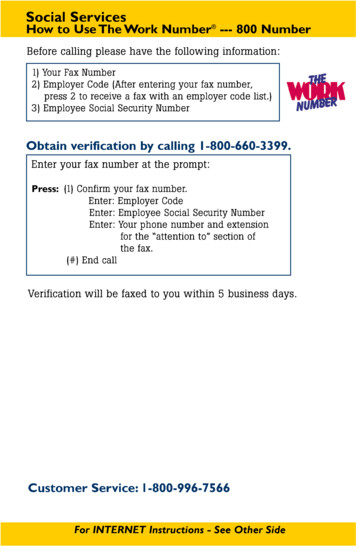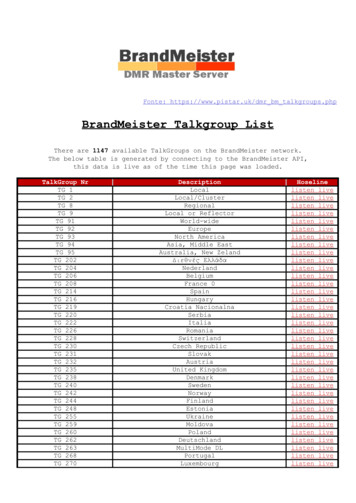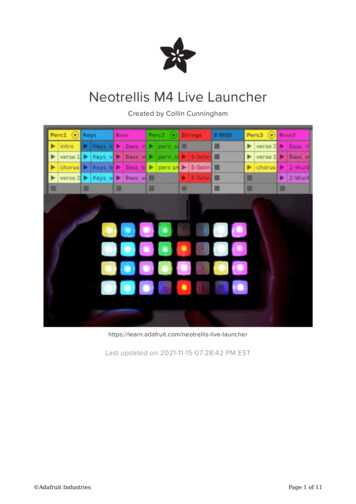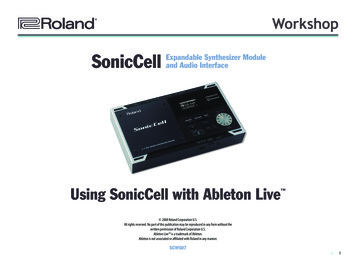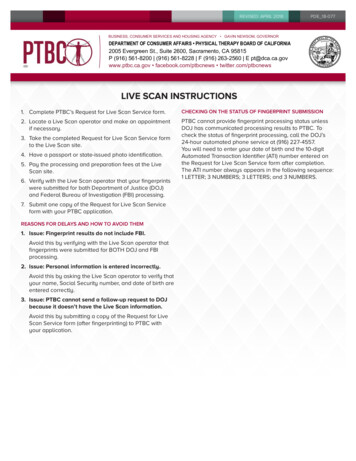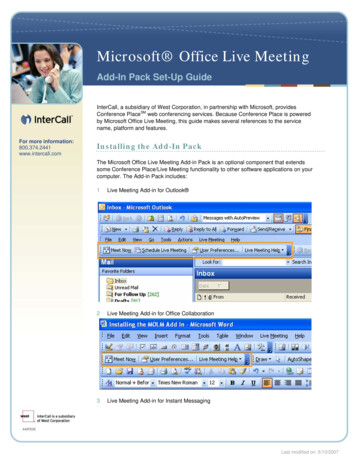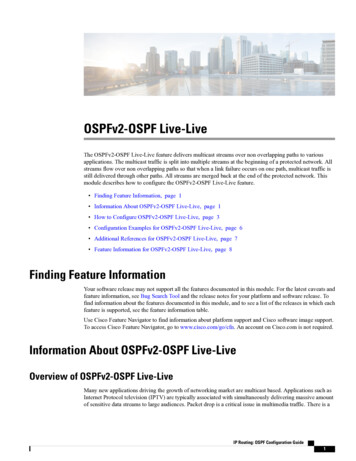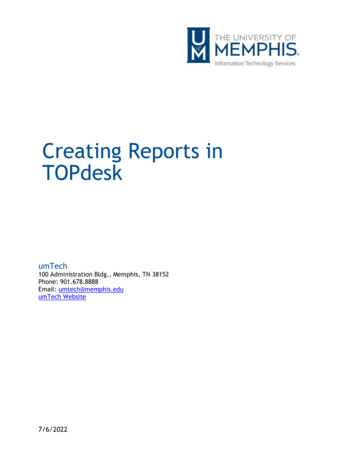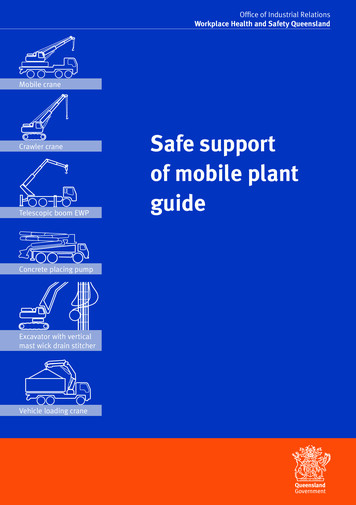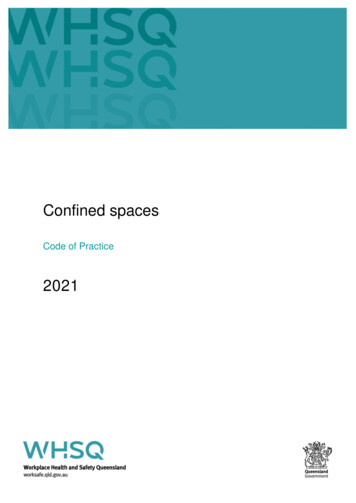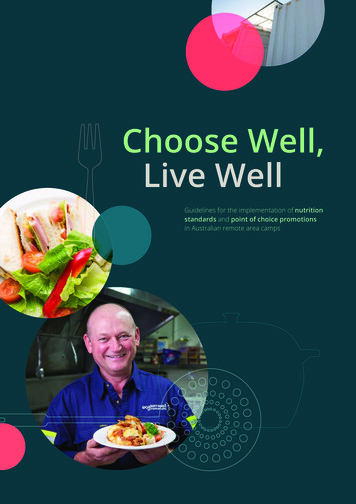
Transcription
Choose Well,Live WellGuidelines for the implementation of nutritionstandards and point of choice promotionsin Australian remote area camps
AcknowledgementsIn 2014, Workplace Health and SafetyQueensland (WHSQ) partnered withEasternwell Camp Management tofund a project aimed at developinga set of nutritional guidelines forAustralian remote area camp foodservices, as part of the QueenslandGovernment Healthier. Happier.Workplaces (formerly known asWorkplaces for Wellness) initiative.The guide takes into considerationthe unique environment andoccupations of workers in remotearea camps.The guidelines are based on currentavailable evidence, based primarilyon the documents listed on page 5,2and developed with considerationof the specific needs of thisworking group.Easternwell Camp Managementwould like to acknowledge andthank those who assisted inthe development of theseguidelines including Easternwellproject managers, camp chefsand workers who participatedin trials, and Workplace Healthand Safety Queensland.Document reviewed April 2020 andaligns with the A Better Choice FoodClassification Guide published by TheState of Queensland (QueenslandHealth) October 2019.
CONTENTSAim4Background5PART 1: Understanding the Guidelines6Choose Well, Live Well7“Choose Most” Green Category8“Choose Moderately” Amber Category8“Choose Least” Red Category9Criteria for Pre-Packaged Foods9Mixed Dish Menu Criteria10Main/Mid-Meal Recipes10Dessert Recipes10Classification System10Minimum Choice Criteria11PART 2: Implementing the Guidelines12Implementing Choose Well, Live Well13PART 3: Healthy Workplace Strategies15Policy Strategies16Environmental Strategies17Portion Sizing and Service17Increased Enhanced Availability of Healthier Choices17Choice Architecture17Recipe Alterations17Educational Strategies18Posters/Educational Material18Traffic Light Labelling18PART 4: Appendices19Appendix 1 – Green, Amber and Red Category Examples20Choose Most Category20Choose Moderately Category21Choose Least Category22Appendix 2 – Determining Classifications (Examples)23Appendix 3 – Cost-Effective Menu Changes26Appendix 4 – Useful Websites27Nutrition Resources27Workplace Health and Well-being Resources273
AimChoose Well, Live Well: Guidelines for the implementation ofnutrition standards and point of choice promotions in Australianremote area camps aims to promote healthy choices within theworkplace canteen in Australian remote area camps.The aim of Choose Well, Live Well is to make the healthy choice, the easy choice through:developing practical nutritional guidelinespromoting healthy options at all meal times by:increasing availability of healthy optionsdecreasing availability of less healthy options encouraging employers to adopt policy, environmental and educational strategiesthat encourage better nutritional choices.The target audience is male and female blue collar employees, workinglong shifts in a variety of sedentary or repetitive roles in the oil, gas, mining,energy, transport, trades and supply chain services sector.The guidelines intend to provide the first standard developed specifically forremote area camps to promote health and nutrition within their workforce.They are designed to be used by camp managers, nutritionists/dietitians,chefs, menu planners or others involved in the development, planning orimplementation of menus in these industries.4Choose Well, Live Well Guidelines for the implementation of nutrition standards and point of choice promotions in Australian remote area camps
In Australia,the burdenof chronic diseaseis on the rise, withapproximately 63 percent of Australian adultslisted as overweightor obese1.BackgroundIn a 2009 report on Australian workersand chronic disease, 33 per cent ofAustralian workers reported sufferingfrom a chronic disease2. A furtherstudy in 2010 by the AustralianInstitute of Health and Welfare (AIHW)found that 96 per cent of thosesurveyed had at least one modifiablerisk factor, including smoking, poordiet, stress, low physical activityor high alcohol consumption3.Australians are predicted to spendone third of their lifetime at work,and initiatives targeting workingadults have the potential to have alarge impact on reducing these keymodifiable risk factors.In addition to the general risk factorsof working adults, shift workers(and particularly fly in fly out (FIFO)workers) are susceptible to furtherrisk factors which impact heavily ontheir health and well-being. Shiftwork has been associated withan increased risk of weight gainand obesity, as well as a higherfrequency of meal intake and/orpoor nutritional intake, leading shiftwork to have a negative impact onhealth and well-being4. In addition tothis, FIFO work has been associatedwith an even higher risk of beingoverweight or obese and havingpoor nutrition5.Remote area work camps in Australiaare a particularly unique subset ofthe working Australian population.Employees in these worksites areestimated to receive approximately50 per cent of their yearly nutritionalintake while at work. Typically,employees in remote area campshave limited or no access to externalsources of food and rely on the foodprovided by the camp. This poses aunique challenge when it comes tonutrition and overeating, as thereis usually an abundance of foodavailable with no limits on servingsizes/amounts. Combined with alimited understanding of appropriateportion sizes and/or what constitutes abalanced diet, this can have significantimpact on weight gain while at work.This creates an excellent opportunityto provide these employees withhealthy, nutritious foods that willencourage a healthier and moreresilient workforce. However, the FIFOworkforce tends to have poorer healthoutcomes. When an employer is solelyresponsible for the provision of foodfor their employees, it is vital to leadby example by providing a physicaland organisational environment thatis supportive of making the healthychoice, the easy choice.The Choose Well, Live Well guidelinetargets food service in remote areacamps around Australia. It deliversa standard for providing healthymeal options to employees withinthese camps, as well as providinginformation on how to implement theguidelines and promote healthy eatingin the field.Supporting documents forthe development of theseguidelines include: Better Choice Food ClassificationAGuide published by The State ofQueensland (Queensland Health)October 2019 Better Choice: Healthy FoodAand Drink Supply Strategy forQueensland Health Facilities ealthy Choices: Food and DrinkHClassification Guide (HealthyTogether Victoria) mart Choices: Healthy FoodSand Drink Supply Strategy forQueensland Schools he Australian Dietary GuidelinesT(2013) The Foundation Diet Nutrient Reference Values.1. Australian Institute of Health and Welfare 2011-12. Australian Bureau of Statistics Australian Health Survey. Canberra: AIHW.2. Australian Institute of Health and Welfare 2009. Chronic disease and participation in work. Cat. no. PHE 109. Canberra: AIHW.3. AIHW 2010. Risk factors and participation in work. Cat. no. PHE 122. Canberra: AIHW. Viewed 20 May 2015 http://www.aihw.gov.au/publicationdetail/?id 6442468339 .4. Amani & Gill, 2013, ‘Shiftworking, nutrition and obesity: implications for workforce health – a systematic review’, Asia Pacific Journal of Clinical Nutrition,22 (4): 698-708.5. Joyce, Tomlin, et. al., 2013, ‘Health behaviours and outcomes associated with fly-in fly-out and shift work in Western Australia’, Internal Medicine Journal,43(4): 440-444.5
PART 1Understanding the Guidelines6Choose Well, Live Well Guidelines for the implementation of nutrition standards and point of choice promotions in Australian remote area camps
Choose Well, Live WellThe criteria used in this guide is based around the well-known“Traffic Light” system for menu labelling, which classifies foodsinto three categories – Green (choose most), Amber (choosemoderately) and Red (choose least).Traffic Light Labelling is a commonmethod for classifying foodaccording to the healthfulness of aproduct/menu item. While there areno overall standardised guidelinesfor what constitutes a Green, Amberor Red menu item, generally, levelsof nutrients which exceed the dietaryrequirements of sodium or saturatedfat, as well as volume of vegetable/fruit/wholegrains/lean protein/low fat dairy are considered 6,7.The implementation of traffic lightsystems in other workplaces hasseen some benefits, includinginfluencing employees to makehealthier purchases, increasingawareness of healthy/unhealthyfoods and overall improvement tohealth. As well as this, regulating theproportion of Green/Amber/Redfoods available in the cafeteria/diningroom can have a positive influenceon the types of foods served8.This resource provides informationon the colour classification for awide range of foods and food types,and includes a criteria for recipesthat are cooked fresh on-site andcontain multiple ingredients, as wellas packaged items with NutritionInformation Panels (NIP). Foodvariety is a vital part of a healthydiet and consuming a wide rangeof foods from the 5 food groupsis important to obtain a variety ofessential vitamins and minerals tokeep healthy and alert. As such, aminimum choice criteria has beendeveloped to address food varietyand ensure a wide range of foods areoffered at all times.Point of Choice Promotions (POC)are a key strategy for promotinghealthier options. They can be usedas an education tool, by providingemployees with informationregarding nutrition to encouragethem to make healthier choices.POC promotions are particularlyimportant for promoting a healthyfood culture within the workplaceand can range from postersto choice architecture. Furtherinformation on these strategies hasbeen included in Part 3: HealthyWorkplace Strategies. Links toother organisations that providefurther resources can be found inAppendix 4.6. Sonnenberg, Gelsomin, et. al., 2013, ‘A traffic light food labelling intervention increases consumer awareness of health and healthy choices at the pointof-purchase’, Preventative Medicine, 57: 253-257.7. Victorian Department of Health, 2010, ‘Healthy Choices – food and drink guidelines for Victorian public hospitals, Melbourne, Victoria.8. Donohoe Mather & McGurk, 2014, ‘Promoting Healthy Snack and Beverage Choices in Hawai’i Worksites: The Choose Healthy Now! Pilot Project’, Insightsin Public Health, 73(11): 365-370.7
“Choose Most” Green CategoryGreen items on the menu should beactively promoted and aim to fill atleast 50 per cent of the menu. Thiscan be achieved by:e nsuring that there is alwaysenough stock of Green menu items including Green menu itemsat all meals and snackss tocking water and plain, low-fatmilk in prominent areas (such ason dining tables or at eye level inthe fridge).Green options are based on thoserecommended in the AustralianDietary Guidelines (2013). Eating awide range of foods from each of thefood groups is important for optimalnutrition and to obtain a variety ofessential vitamins and minerals.A table outlining foods and drinksthat can automatically be labelledGreen can be found in Appendix 1.These options are the best choicesas they are:g reat sources of essential nutrientsa re low in added fat, salt and sugara re generally lower in energyp rovide fibre.“Choose Moderately”Amber CategoryAmber choices should not beactively promoted within theworkplace and should fill no morethan 30 per cent of the menu.A table outlining foods and drinksthat can automatically be labelledAmber can be found in Appendix 1.Generally, Amber choices should beprovided in smaller serve sizes thanGreen menu items (where possible).These options are listed as “choosemoderately” as they: can provide some essential nutrients contain added sugar, sodium, or fatc an provide excess kilojoulesif consumed in high quantities.8Choose Well, Live Well Guidelines for the implementation of nutrition standards and point of choice promotions in Australian remote area camps
“Choose Least” Red CategoryRed choices should not bepromoted to employees and shouldbe limited to no more than 20 percent of the menu.These menu choices shouldnot displace Green items or bedisplayed prominently, especiallyat the expense of displayinghealthier options. are energy dense rovide excess kilojoules whenpeaten in high quantities and oftendisplace essential nutrients.A table outlining foods and drinksthat can automatically be labelledRed can be found in Appendix 1.Red choices are menu items that: are high in salt, sugar, or fat have little or no nutritional valueCriteria for Pre-Packaged FoodsTo determine if a pre-packaged(i.e. food item that is bought on-siteand served as is) menu item fits intothe Red category (as opposed tothe Amber category), use the menunutrient criteria table. If an item hasa high amount of any of the criteria,it must be labelled Red.For further information andexamples of how to use the table,see Determining Classifications(Examples) in Appendix 2.When using the criteria, assess thefood against the appropriate mealtime e.g. if the item is being offeredas a snack/mid meal, use the midmeal criteria.NB: This criteria only applies tofood items not listed in Appendix 1(Choose Least Category) asautomatically Red.Menu Nutrient CriteriaMid Meals/SnacksEnergy per serve 800kJTotal Fat (Per 100g) 10gSaturated Fat (per 100g) 3gSodium (per 100g) 400mgSide DishesEnergy (per serve) 500kJTotal (per 100g) 10gSaturated Fat (per 100g) 3gSodium (per 100g) 400mgMeals (Lunch/Dinner)Energy (per serve) 2000kJTotal Fat (per 100g) 10gSaturated Fat (per 100g) 3gSodium (per 100g) 400mgDessertEnergy (per serve) 800kJTotal Fat (per 100g) 10gSaturated Fat (per 100g) 3gSodium (per 100g) 400mg9
Mixed Dish Menu CriteriaAs this is such a unique population, where all meals andbeverages are provided for the employee, it requires a uniqueset of guidelines in conjunction with the standard guidelinesto allow for different foods provided while at work.These guidelines relate to recipescontaining more than one ingredientthat are cooked fresh on-site bychefs. Examples of foods included inthese guidelines would be a stirfry,burritos, stews, soups, or hot pots.There are two sets of criteria todistinguish between mains/midmeals and desserts. The guidelinesare based around positive criteriaand negative criteria based on bothingredients and specific nutrients.Main/Mid-Meal RecipesPositive main ingredients(i.e. first three ingredients listedby volume)Green menu optionNegative*s aturated Fat 3g/100gs odium 300mg/100gDessert RecipesNegative* main ingredientss aturated Fat 3g/100g(i.e. first three ingredients listedGreen menu optiona dded Sugar 5g/100g (excludessugar from natural sources such asplain dairy/fruits)Green recipe.m ain ingredient is a Red option.by volume)For a mixed dish to be classifiedGreen it must have all positivecriteria and no negative.For a mixed dish to be classifiedAmber it will have an equalnumber of positive and negativecriteria OR one negative criteria(regardless of Green).For a dish to be classified as Redit will have more negative thanpositive criteria OR be deep friedOR contain added confectionary.m ain ingredient is a Red option.Green recipe.PositiveClassificationSystemThese guidelinesapply to all recipesincluding main, side,dessert and mid meal/snacks. If the recipe includesa pre-packaged ingredient,refer to the Criteria forPre-Packaged Foods onpage 9 to classify theingredient.* If a main ingredient comes under the Amber category, it is “neutral” i.e. it does not count towardspositive or negative criteria.10Choose Well, Live Well Guidelines for the implementation of nutrition standards and point of choice promotions in Australian remote area camps
Minimum Choice CriteriaWhile employees in remote area camps are at work, they aretypically provided with 100 per cent of their nutritional intake.It’s important that employees areprovided with a wide variety offoods from each of the differentfood groups, as well as subgroupswithin these, to ensure they areable to meet all of their nutritionalrequirements. To achieve this, aminimum choice criteria has beendeveloped, based on the NationalHealth and Medical Research Council(NHMRC) “Foundation and TotalDiets” which provides advice on therecommended serves per week ofeach of the composite food groups.Recommended serves per week per composite food groupFood GroupServes/weekStarchy Vegetables7Green and Brassica Vegetables7Orange Vegetables7Legumes7Nuts/Seeds7Other Vegetables14Fruit14Wholegrains cereals/grains28Refined Cereals/grains(can be replaced with wholegrain)14Meat and alternatives (Not red meat)7Red Meats (Beef, Lamb, Veal, Pork)7Dairy Foods17This means that across the courseof a week, all of these foods mustbe offered the number of timesstated e.g. starchy vegetables mustbe offered at least seven times in aweek, fruit must be offered at least14 times etc. While it is importantto offer a variety of foods withineach group over the course ofthe week, the same food could beoffered multiple times to allow forseasonality, expense and availabilityof different food items.11
PART 2Implementing the Guidelines12Choose Well, Live Well Guidelines for the implementation of nutrition standards and point of choice promotions in Australian remote area camps
Implementing Choose Well, Live WellThe primary goal of Choose Well, Live Well is to increase theproportion of healthy food and drinks offered on work campsites, while simultaneously decreasing the amount of lesshealthy choices available.The aim is to promote a workplaceculture where making healthychoices every day becomes secondnature. Implementation of theseguidelines can be broken downinto some simple steps, which aredetailed below.Implementation of these guidelinescan be broken down into five steps:For the purposes of the assessment,it is suggested to place foods andproducts into the following groups,to help assess them:1. Assess the foods offered2. D etermine proportions of Green,Amber and Red choices main meals3. Implement changes snacks (including sweetsand savouries)4. C heck new proportions meettraffic light criteria drinks.5. Promote your changesStep 1: Assess the foods offeredThe first step of implementingthe guidelines is to assess thefoods, recipes and drinks offeredon-site. Each food or menu itemshould be categorised into Green,Amber or Red. Use the tables andcriteria found on pages 9-10 and inAppendix 1 to assist with this.Many foods will be listed in thetables in Appendix 1 and can beautomatically labelled as such.You can also use the menudecision flowchart opposite tohelp determine which categorya menu item fits into.Is the food listed specifically under theGreen/Amber/Red criteria? (see Appendix 1)YESNOLabel accordinglyDoes the food item/meal havea nutrition information panel?YESNOCheck againstappropriate Criteriafor Pre-PackagedFoods ( see page 9)Have any of thecriteria beenexceeded?YESClassify as RedHave you added multiple ingredientstogether, i.e. a recipe?(excluding small amounts of oil/salt for cooking purposes)YESNOCheck against MixedDish criteriaCheck against Green/Amber criteriaNOClassify as Amber13
Step 2: Determine proportions of each of theGreen, Amber and Red menu itemsTo determine the proportion ofGreen, Amber and Red choices,count the number of meals, withineach group, across a menu cycleand divide by the total number.Hypothetical example:If there are five Green mains, six Amber mains and ten Red mains(total of 21 meals for the week):Green Mains: 5/21 24%Amber Mains: 6/21 28%Red Mains: 10/21 48%Step 3: Implement changesTo fit with the Choose Well, LiveWell criteria, proportions of Green,Amber and Red should be 50%, 30% & 20%, respectively.In this example, only the Amber category fits within the guidelines of ChooseWell, Live Well. Green options should be increased to 50 per cent, while Redoptions should be limited to less than 20 per cent of choices. For ways toimprove the nutritional quality of Red food items see Appendix 3.Step 4: Check the new proportionsThis step involves checking thechanges to the menu to ensurethey meet the criteria for theproportions of Green, Amberand Red.Similar to step 2, this involvescounting the menu items withineach category across a menucycle and dividing this by thetotal number.For example, changes made to the menu have provided 13 Green, six Amberand two Red:Green: 13/21 62%Amber: 6/21 28%Red: 2/21 10%The new changes to the menu have succeeded in meeting the guidelinerecommendations.In addition to this, there are guidelines for the display and marketing ofGreen, Amber and Red items that should also be considered. See pages 8and 9 for further details on this.Step 5: Promote your changesLet your employees know aboutthe changes you have made andpromote a positive health culturein the workplace by including someposters/pamphlets/brochures inthe eating areas.14External organisations who provide useful resources are listed in Appendix 4.Choose Well, Live Well Guidelines for the implementation of nutrition standards and point of choice promotions in Australian remote area camps
PART 3Healthy Workplace Strategies15
There are a number of strategies that employers can adoptto support workers in making positive nutritional choices.These strategies include developing and implementing policiesthat ensure the ongoing growth and sustainability of healthinitiatives, altering the environment to be more conducive ofhealthy behaviours and educating employees on how to makehealthier choices.The key challenges facing remotearea workplaces include: the availability of largeamounts of food higher energy intake associatedwith dining in a restaurant likesituation, eating from a selfserve buffet and access to largeportion sizest he size of crockery and glassesare larger than 50 years ago andthis affects the amount of foodand drink consumed, with largercutlery and dishes encouragingincreased portion sizes.Having anunderstandingof the challengesfacing these workplacesand how to overcomethese can help withencouraging healthychanges.Promoting health and healthychoices at the Point of Choice(POC) has been shown to havea positive influence on improvingfood choices and the amountof food eaten.Policy StrategiesDeveloping, implementing and reviewing workplace policies canensure that any health and wellness initiatives are sustainable.The policy can be a specific foodand drink access policy orincluded in current relevantorganisational policies witha point about meeting thestandards for these guidelines,to ensure that compliance iscontinually achieved.16Policy templates can be foundon the Health and Wellbeing atWork website or Cancer CouncilQueensland QUEST website.Policies are important to outline thecommitment of the workplace toachieving better health outcomesfrom their employees.Choose Well, Live Well Guidelines for the implementation of nutrition standards and point of choice promotions in Australian remote area camps
Environmental StrategiesPortion Sizing and ServiceResearch conducted in restaurantshas found that when people dine out,they tend to consume more kilojoulesthan when they eat at home9.The work camp environment issimilar to eating in a restaurant everyday as food is prepared and servedby others, and this is potentiallyfurther exacerbated as remote areaworkers will consume all of theirfood for extended periods of timein these restaurant-like situations.Other research has also found thatwhen diners are presented witha self-serve buffet, they tend toconsume more calories9. Researchfrom the Cornell Food and Brand labhas found that the size of crockery,plates and glasses can also have animpact on serving size, with researchfrom the same lab finding thatlarger plates and cutlery encourageconsumption of larger portions,while tall slender glasses and smallerplates tend to result in less foodconsumed. Modifying the size ofthe cutlery, crockery and glassescan result in up to a 15 per centdecrease in calorie intake9. Changingto smaller plates, cutlery, glasses andplastic lunch containers is a simplemeasure to implement that couldhave a large impact on reducingserving sizes in the camps.Increased Enhanced Availability of Healthier ChoicesTo encourage healthy selections, itis important to ensure that thereis an extensive variety of appealinghealthy choices available.Choose Well, Live Well recommendshaving a minimum of 50 per centhealthy Green options availableat all times and limiting unhealthyRed options to no more than20 per cent (less if possible) of themenu. This is in line with otherAustralian guidelines includingthe Queensland Health A BetterChoice: Food Classification Guide10.To maintain this, it is importantto always have stock of healthychoices available.Choice ArchitectureChoice architecture relates tothe design of ways of presentingchoices to consumers and theimpact this has on selections.Choice architecture can be seen inmany different environments fromthe way supermarket shelves arearranged to the presentation of food.Concepts of choice architecture canbe utilised in the remote area campenvironment to subtly persuadeplaced first in the buffet, patronsworkers to make healthier choices.made healthier food selections11.Simple measures such as placingWorkplaces could promote healthiersugary drinks out of eyeline (e.g. atoptions in this way or require thatthe bottom of the fridge), placingless healthy options must be askedhealthier options in eye sight andfor (e.g. placing the sugary cerealseven the placement of foods in aout of eye sight and placing healthierbain-marie can have an impact onoptions such as wheat biscuits/flakesfood selection behaviour. One studyat the breakfast bar or having deepshowed that when healthy foods arefried by request only).Recipe AlterationsA consideration when makingchanges to menus is the costeffectiveness of implementinglarge-scale changes.Fortunately, Choose Well, Live Welldoesn’t necessarily require costlychanges. There are a number ofalterations that can be made toyour current menu that can greatlyimprove the health qualities of thefood provided. A list of ways to reduceunhealthy options and replace withnutritious cost effective foods is listedin Appendix 3.9. Wansink, B. (2010). Mindless eating: why we eat more than we think. London: Hay House.10. A Better Choice Food Classification Guide published by The State of Queensland (Queensland Health) October 2019(https://www.health.qld.gov.au/ data/assets/pdf )11. Wansink & Hanks, 2013, ‘Slim by Design: Serving Healthy Foods First in Buffet Lines Improves Overall Meal Selection’, PLoS ONE, 8(10): e77055.17
Educational StrategiesPosters/Educational MaterialProviding education at the POC through the use of posters and handoutscan have a positive influence on food selection behaviours.These benefits have been shownposters and information highlightingwhen combined with other POCthe effects of sugary drinks and thestrategies such as increasing healthyamount of sugar in drinks which can beoptions10,12 labelling10,12,13,14 and choicedisplayed in schools and workplaces.architecture14. The Australian GuideOther promotions could display theto Healthy Eating is an excellentnew criteria in a poster or servietteresource which provides informationholder, display pamphlets/brochures inon consumption of the different foodthe dining room or have a poster withgroups and what makes up the foodan example of how to build a healthygroups. The Rethink Sugary Drinkplate (such as the Nutrition Australiawebsite has free downloadableHealthy Plate Model).Traffic Light LabellingTraffic Light Labelling is a well-researched concept in POC Labelling.Many studies have found thattraffic light labelling is effective ininfluencing consumers when makingfood decisions12,13,14. An Australianstudy found that there was no ‘better’format to use between multiple trafficlights, single traffic lights and a starrating, however all formats performedbetter than just providing a nutritioninformation panel or energy contentalone15. An example of how to displaythis information can be found below.BEEF MALAY CURRYBEEF LASAGNEContains vegetablesand lean meatContains lean meatLow in saturated fat and sodiumHigher in saturated fatand sodiumFree of egg, gluten, lactose,peanuts, sesame and shellfishFree of egg, soy, tree nuts,peanuts, sesame and shellfishBEEF SPRING ROLLSContains vegetablesHigh in sodium and deep friedFree of egg, lactose, tree nuts,peanuts, sesame10. M iller, Lee, Obersky, et. al., 2013, ‘Implementation of A Better Choice Healthy Food and Drink Supply Strategy for staff and visitors in governmentowned health facilities in Queensland, Australia’, Public Health Nutrition.\12. D onohoe Mather & McGurk, 2014, ‘Promoting Healthy Snack and Beverage Choices in Hawai’i Worksites: The Choose Healthy Now! Pilot Project, Insightsin Public Health, 73(11): 365-370.13. S onnenberg, Gelsomin, Levy, et. al., 2013, ‘A traffic light food labelling intervention increases consumer awareness of health and healthy choices at thepoint-of-purchase’, Preventative Medicine, 57: 253-257.14. T horndike, Riis, Sonnenberg, et. al., 2014, ‘Traffic-Light Labels and Choice Architecture Promoting Healthy Food Choices’, American Journal of PreventativeHealth, 46(2): 143-149.15. W atson, Kelly, Hector et. al., 2014, ‘Can front of pack labelling schemes guide healthier food choices? Australian shoppers responses to seven labellingformats’, Appetite, 72: 90-97.18Choose Well, Live Well Guidelines for the implementation of nutrition standards and point of choice promotions in Australian remote area camps
PART 4Appendices19
Appendix 1 – Green, Amber and RedCategory ExamplesChoose Most CategoryThe “Choose Most” Category table below provides a list of examples of menuitems that can be labelled as Green. Plain refers to a product without addedseasoning, flavours,
Choose Well, Live Well: Guidelines for the implementation of nutrition standards and point of choice promotions in Australian remote area camps aims to promote healthy choices within the workplace canteen in Australian remote area camps. The aim of Choose Well, Live Well is to make the healthy choice, the easy choice through:

